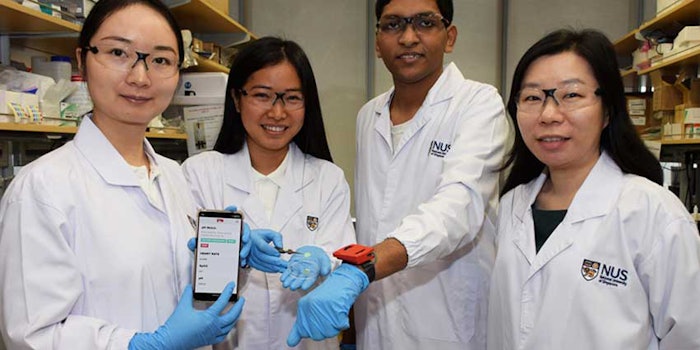
Variations in sweat pH, i.e., acidity or alkalinity, can tell whether the body is dehydrated and can aid the diagnosis of skin conditions such as dermatitis, acne and other skin infections.
In diabetic patients, for example, sweat pH may serve as a good indicator of other life-threatening conditions. For instance, during excessive and/or night sweating, a high pH may be caused by a prolonged period of low blood glucose that warrants medical intervention.
In relation, a team of researchers at the National University of Singapore (NUS) has designed a wearable health monitoring gadget that can tell users about the condition of their health from their sweat. The novel sweat pH monitor, which according to the inventors can be easily integrated into existing fitness trackers or smart watches at a very low cost and can continuously measure and monitor the acidity or alkalinity level of a user’s sweat, along with their heart rate and oxygen concentration. In this way, users have a constant, personalized and non-invasive assessment of their well-being.
The pH Watch invented by the NUS researchers leverages the existing pulse oximeter chips in fitness trackers and smart watches that measure the heart rate and oxygen saturation levels of users.
“Most present-day fitness trackers and smart watches can measure health indicators such as heart rate, blood oxygen saturation levels, step count and even sleep cycle, but they are not able to track health indicators at the molecular level,” noted Ananta Narayanan Balaji, a doctoral student at the NUS Department of Electrical and Computer Engineering, in a press announcement. “Hence, we created the pH Watch because sweat is a readily accessible bodily fluid composed of a wide array of biochemical markers that can be used to monitor the well-being of individuals in a non-invasive manner.”
The pH Watch is the first demonstration of a reusable sweat sensor that can be readily integrated into today’s smart watches with pulse oximeters, paving the way for ubiquitous sensing of biomarkers.
“When the body is dehydrated, there will be an increase in the concentration of sodium in sweat, which is indicated by a higher pH value. A balanced pH is also essential for skin health—If our skin is too acidic or alkaline, skin conditions such as dermatitis and acne can occur. For diabetic patients, a high sweat pH during excessive sweating and night sweating may suggest that the patient is experiencing low blood glucose levels,” Narayanan Balaji continued.
As the researchers explain, pulse oximeters consist of red and infrared light sensors that sit between the skin and the device. They emit visible red and invisible infrared light onto the users’ skin and calculate the difference between the wavelengths of the two lights to determine the oxygen content in the blood. In hospitals, they are often clipped on the top of a patient’s index finger to measure and monitor the blood oxygen saturation level of the patient.
The NUS team sought to fabricate a flexible and highly responsive pH sweat sensor that works well with pulse oximeters. Specifically, the sweat sensor is made using a material that changes color when it contacts different sweat pH levels. These color changes are designed to match the recording capabilities of the pulse oximeter. By integrating this custom-made pH sensor and the team’s pH sensing algorithm into existing fitness trackers or smart watches, which already have a built-in pulse oximeters, the pH Watch can simultaneously monitor the pH value of a user’s sweat, along with heart rate and blood oxygen saturation values in real-time, with approximately 90% accuracy.
“We designed and fabricated the pH sensor from scratch using polyaniline polymer, which is an inexpensive, durable yet very flexible material,” said Chen Yuan, another doctoral student at the NUS Department of Electrical and Computer Engineering. “It conforms well to the skin and can be added to any smartwatch with the pulse oximeter to enable continuous measurement of sweat pH. The sensor can be reused for more than a year even with daily use.”
Narayanan Balaji explains, “Our pH Watch works very efficiently. It only requires 20KB of Random Access Memory (RAM) for data processing. It is also very power-efficient—the pH sensor is passive and does not require a power source, while the pH sensing algorithm uses less than 0.01% of the total power consumption of a smart watch.”
“To our best knowledge, the pH Watch is the first demonstration of a reusable sweat sensor that can be readily integrated into today’s smart watches with pulse oximeters, paving the way for ubiquitous sensing of biomarkers,” said Shao Huilin from the NUS iHealthtech and NUS Department of Biomedical Engineering.
For more information, visit the NUS website.










